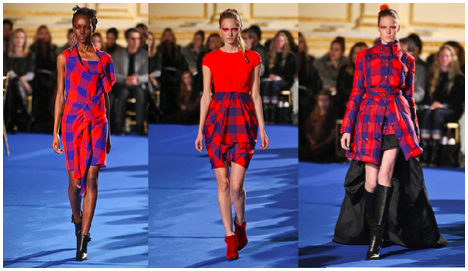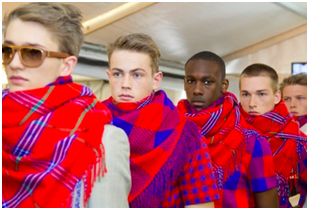ESSAY STATEMENT: “THE MORE WE LEARN ABOUT CULTURE, THE GREATER OUR UNDERSTANDING OF THE FUTURE OF GLOBAL CONSUMERISM IN FASHION.”
- 1500 word essay
- 40% of whole of ALAC grade
- Essay statement: “The more we learn about culture, the greater our understanding of the future of global consumerism in fashion.”
- Consumerism: protection and promotion of the interests of consumers
- What aspects of culture, what future? = define the key words through reading
- Always give examples and backup statements in essay
- Tonight research on global consumerism
- In your essay, you need to answer the “why” and make comparisons- going to be reading a lot on psychology of people
- A topic to look at could be identity
- Theodore Levitt- “The Globalization of Markets” (READ)
- Marketing Strategies: Global strategy: uniform product and uniform message, Local strategy: customized product/customized message
- Task: analyze the statement, paying attention to the key words/terms – what are they? What do they mean to you? Notice: The keywords should be used in the essay. Discuss and negotiate what you think about the statement and how you could discuss this in your essay.
1. Think of following questions and write sentences/answers
What makes consumerism global?
– Connections around the world, between countries, between nations. The promotion of the interest of consumers is endorsed through the world/globally. Also because of the various cultures who share different but similar tastes and needs.
– Online shopping
– Internet
– Media
– Global connections and trade links have always been in existence
How can the theories of ‘global’, ‘local’ and ‘glocal’ be related to consumerism?
- Local is sort of more focusing on one group/culture etc and understanding their needs/what they consume.
Definition of theory: an idea or set of ideas that is intended to explain facts or events. An idea that is suggested or presented as possibly true but that is not known or proven to be true. The general principles or ideas that relate to a particular subject.
NOTES ON ARTICLE: The future for fashion – Matthew Jeatt (on paper)
NOTES ON 3 PIECES OF READING:
- “The Tomorrow People” – Raymond
- “The big truth: a brand loses its way when it loses touch with its customers’ needs”
- “Consumers want to buy items that reflect their lifestyle, make them feel better about who they were and where they were going.”
- “Puzzling but hardly surprising – brands, retailers and corporations are now so far away from where consumers want them to be.”
- What I understood from this quote:” Consumers are suffering from brand fatigue, or brand blur as we’ve dubbed it – we are now subjected to more than 3000 brand messages or statements on a daily basis and many of us, rather than succumbing, are just saying no. Which, to borrow a term from the world of complexity theory, has brought us to that point in culture where things become ever more complicated and complex, before, yes you’ve guessed it, they fall apart or implode into something far simpler and more in tune with the market’s needs.” Today culture has become more complex, unlike in the old days where trends/fashion would just fall apart and develop in to something new, something simpler. Whereas today it is much harder to fulfill the market’s needs, as well as the consumers’.
- In order to attract consumers and to fulfill their needs, “you have to create and inhabit a very particular kind of company or brand – one we call tactile.” “The tactile brand is about tactility in the way that we understand reaching out, as in connecting, digging down into a culture. It’s about brailing – feeling, touching and seeing the world around us as it shifts and moves in engaging, measures, emotional and poetic way.”
- “Brailing is about living customers’ lives or ‘lifestyle narratives’ in a way that’s keeps you connected to them online. In the field, in their homes, offices and heads, in their spiritual and emotional lives, in their dreams, desires and daily needs.”
- “Tomorrow’s consumers want things their way and if their way changes, as real people change on daily basis, they want the service, brand or company they are dealing with to change with them – this is why the old ways of reading and redefining brands no longer work; why the old ways of profiling customers, or measuring market shifts are redundant.”
- “In this future natural borders still exist – in China, Russia and India they will be stronger than ever, nationalistically, but also notionally in terms of embracing change, brands and a staggered or staged market economy.”
2. “The Sharing of Culture: Global Consumerism”
Kimberly Byrnes
- “Widespread communications are changing how consumers shape their values and how they choose to spend their money. This is leading to the emergence of global citizens who actively participate in a global marketplace where multinational corporations offer brands that meet their evolving needs and wants (Gregory 121).”
- “The combination of global connectivity and a global consumer culture can be called globalization.”
- “C_u_l_t_u_r_e_ _i_s_ _n_o_ _l_o_n_g_e_r_ _t_i_e_d_ _t_o_ _a_ _p_l_a_c_e_ _o_r_ _a_ _b_o_d_y_ _o_f_ _p_e_o_p_l_e_” _b_e_c_a_u_s_e_ _m_o_r_e_ _p_e_o_p_l_e_ _t_h_a_n_ _e_v_e_r_ _h_a_v_e_ _a_c_c_e_s_s_ _t_o_ _a_ _g_l_o_b_a_l_ _n_e_t_w_o_r_k_ _o_f_ _i_n_f_o_r_m_a_t_i_o_n_ _(_R_o_j_e_k_ _6_6_)_._ _T_h_r_o_u_g_h_ _a_ _v_a_s_t_ _n_u_m_b_e_r_ _o_f_ _s_o_u_r_c_e_s_ _– _s_u_c_h_ _a_s_ _t_h_e_ _m_e_d_i_a_,_ _t_e_c_h_n_o_l_o_g_y_,_ _i_n_t_e_r_n_e_t_,_ _a_d_v_e_r_t_i_s_i_n_g_,_ _a_n_d_ _t_r_a_v_e_l_ _– _p_e_o_p_l_e_ _d_i_s_c_o_v_e_r_ _w_h_a_t_ _i_t_ _m_e_a_n_s_ _t_o_ _b_e_ _a_ _g_l_o_b_a_l_ _c_i_t_i_z_e_n_._ _B_e_i_n_g_ _a_ _g_l_o_b_a_l_ _c_i_t_i_z_e_n_ _h_a_s_ _m_a_n_y_ _c_o_n_n_o_t_a_t_i_o_n_s_,_ _b_u_t_ _i_n_ _t_h_i_s_ _c_o_n_t_e_x_t_,_ _i_t_ _i_s_ _a_ _p_e_r_s_o_n_ _w_h_o_ _l_i_v_e_s_ _i_n_ _t_h_i_s_ _w_o_r_l_d_ _o_f_ _c_o_n_v_e_r_g_i_n_g_ _c_u_l_t_u_r_e_s_._ _P_e_o_p_l_e_ _w_o_r_l_d_w_i_d_e_ _a_r_e_ _c_o_n_n_e_c_t_i_n_g_ _w_i_t_h_ _o_t_h_e_r_ _p_e_o_p_l_e_ _a_s_ _w_e_l_l_ _a_s_ _w_i_t_h_ _o_t_h_e_r_ _f_o_r_e_i_g_n_ _c_u_l_t_u_r_e_s_ _t_h_r_o_u_g_h_ _t_h_i_s_ _g_l_o_b_a_l_ _c_o_n_n_e_c_t_i_v_i_t_y_,_ _w_h_i_c_h_ _a_s_ _a_ _r_e_s_u_l_t_ _h_a_s_ _s_h_a_p_e_d_ _global culture” (Storey 117)
- C_o_n_s_u_m_p_t_i_o_n_ _i_s_ _a_n_ _a_c_t_i_v_i_t_y_ _t_h_a_t_ _e_v_o_l_v_e_s_ _o_v_e_r_ _t_i_m_e_ _a_n_d_ _v_a_r_i_e_s_ _f_r_o_m_ _o_n_e_ _c_u_l_t_u_r_e_ _t_o_ _a_n_o_t_h_e_r_ _(_G_o_o_d_m_a_n_ _4_)_._ _O_n_e_ _u_n_i_v_e_r_s_a_l_ _t_r_u_t_h_ _i_s_ _t_h_a_t_ _p_e_o_p_l_e_ _c_o_n_s_u_m_e_ _b_e_c_a_u_s_e_ _t_h_e_y_ _f_i_n_d_ _m_e_a_n_i_n_g_ _i_n_ _m_a_t_e_r_i_a_l_ _g_o_o_d_s_,_ _w_h_i_c_h_ _v_a_r_y_ _f_r_o_m_ _b_e_i_n_g_ _a_ _n_e_c_e_s_s_i_t_y_ _t_o_ _b_e_i_n_g_ _a_ _f_o_r_m_ _o_f_ _s_e_l_f_-_e_x_p_r_e_s_s_i_o_n_ _(_2_)_._ _I_t_ _i_s_ _a_l_s_o_ _t_r_u_e_ _t_h_a_t_ _p_r_o_d_u_c_t_s_ _c_a_r_r_y_ _d_i_f_f_e_r_e_n_t_ _m_e_a_n_i_n_g_s_ _d_e_p_e_n_d_i_n_g_ _u_p_o_n_ _t_h_e_ _i_n_d_i_v_i_d_u_a_l_ _p_e_r_s_o_n_;_ _f_o_r_ _i_n_s_t_a_n_c_e_,_ _t_h_e_ _c_o_m_m_o_n_ _a_p_h_o_r_i_s_m_ _‘o_n_e_ _p_e_r_s_o_n_’s_ _t_r_a_s_h_ _i_s_ _a_n_o_t_h_e_r_ _p_e_r_s_o_n_’s_ _t_r_e_a_s_u_r_e_’._ _T_h_i_s_ _a_l_s_o_ _r_e_l_a_t_e_s_ _t_o_ _M_c_D_o_n_a_l_d_’s_ _b_e_c_a_u_s_e_ _i_n_ _t_h_e_ _U_n_i_t_e_d_ _S_t_a_t_e_s_ _i_t_ _i_s_ _s_e_e_n_ _a_s_ _a_ _f_a_s_t_,_ _c_h_e_a_p_,_ _a_n_d_ _c_o_n_v_e_n_i_e_n_t_ _f_o_o_d_,_ _w_h_e_r_e_a_s_ _i_n_ _c_o_u_n_t_r_i_e_s_ _l_i_k_e_ _A_r_g_e_n_t_i_n_a_ _a_n_d_ _C_h_i_n_a_,_ _i_t_ _t_a_k_e_s_ _o_n_ _a_n_o_t_h_e_r_ _m_e_a_n_i_n_g_ _(_A_s_g_a_r_y_)_._ _P_e_o_p_l_e_ _i_n_ _A_r_g_e_n_t_i_n_a_ _a_n_d_ _C_h_i_n_a_ _v_i_e_w_ _M_c_D_o_n_a_l_d_’s_ _a_s_ _a_ _c_u_l_t_u_r_a_l_ _e_x_p_e_r_i_e_n_c_e_ _t_h_a_t_ _p_r_e_s_e_n_t_s_ _a_n_ _A_m_e_r_i_c_a_n_ _a_m_b_i_a_n_c_e_ _a_s_ _w_e_l_l_ _a_s_ _s_o_u_v_e_n_i_r_s_ _– _l_i_k_e_ _n_a_p_k_i_n_s_,_ _s_t_r_a_w_s_,_ _a_n_d_ _p_a_c_k_a_g_i_n_g_ _– _t_h_a_t_ _a_r_e_ _o_f_t_e_n_ _k_e_p_t_ _u_p_o_n_ _f_i_n_i_s_h_i_n_g_ _a_ _m_e_a_l_._ _T_h_e_r_e_f_o_r_e_,_ _i_l_l_u_s_t_r_a_t_i_n_g_ _h_o_w_ _i_m_p_o_r_t_a_n_t_ _i_t_ _i_s_ _t_o_ _u_n_d_e_r_s_t_a_n_d_ _t_h_e_ _m_e_a_n_i_n_g_s_ _b_e_h_i_n_d_ _c_o_n_s_u_m_p_t_i_o_n_ _i_n_ _o_r_d_e_r_ _t_o_ _u_n_d_e_r_s_t_a_n_d_ _a_ _c_u_l_t_u_r_e_._ _
- A_ _‘c_o_n_s_u_m_e_r_ _c_u_l_t_u_r_e_’ _i_s_ _a_ _r_e_l_a_t_i_v_e_l_y_ _n_e_w_ _c_o_n_c_e_p_t_ _t_h_a_t_ _n_o_t_ _o_n_l_y_ _d_e_f_i_n_e_s_ _h_o_w_ _t_o_ _s_a_t_i_s_f_y_ _o_n_e_’s_ _n_e_e_d_s_ _a_n_d_ _w_a_n_t_s_,_ _b_u_t_ _h_a_s_ _a_l_s_o_ _b_e_e_n_ _s_u_c_c_e_s_s_f_u_l_ _i_n_ _r_e_d_e_f_i_n_i_n_g_ _o_n_e_’s_ _n_e_e_d_s_ _a_n_d_ _w_a_n_t_s_ _(_5_)_._ _A_s_ _T_h_e_o_d_o_r_e_ _L_e_v_i_t_t_ _s_t_a_t_e_d_ _i_n_ _1_9_8_3_,_ _“A_l_m_o_s_t_ _e_v_e_r_y_o_n_e_ _e_v_e_r_y_w_h_e_r_e_ _w_a_n_t_s_ _a_l_l_ _t_h_e_ _t_h_i_n_g_s_ _t_h_e_y_ _h_a_v_e_ _h_e_a_r_d_ _a_b_o_u_t_,_ _s_e_e_n_,_ _o_r_ _e_x_p_e_r_i_e_n_c_e_d_ _v_i_a_ _t_h_e_ _n_e_w_ _t_e_c_h_n_o_l_o_g_y_” _(_9_2_)_._ _
- Consumption and everyday life by Mark Paterson
- The definition of consumption is a paradox. The word consumption derives from consumer which means to “use up and to destroy” and in Latin consumare means to bring completion – to have sex. Therefore consumption simultaneously means destroying (using up) and creating (bringing to fulfillment)
- Question to consider: what to changes in commodity markets, the growth of global media and advertising, and the expansion of cross-cultural tourism, actually mean to us as consumers? How does this affect us in everyday acts of consumption?
- Distinction between consumption and consumerism. Consumption is not simply a series of individual acts of purchasing, as if purchasing a product were an end in itself. “consumerism”, at least in the UK, is a mostly pejorative term, indicating the unreflective practices of people who apparently mindlessly buy into gadgets, technologies, brands and labels as a way of life.
- Consumer Culture- Celia Lury
- Consumer culture is a proliferation (increase in something) of spaces, platforms and modes of consuming, including for example, an increase in the range of different forms of shopping: internet, retail tourism, mail-order, shopping malls, pop-up shops, farmers’ markets, vintage and second-hand shops.
- Consumer culture is a type of material culture: a culture of the use or appropriation of objects or things.

Solution
Global Consumerism in Fashion
Introduction
The extensive expansion of the fashion industry in the recent years promises an even greater growth in the future. The industry has recorded immense growth following the increased globalization and the technological advancement experienced across the world. Different factors have influenced the growth of the industry. However, culture has played a significant role in the increased consumerism and spread of fashion, which has triggered increased growth and development of the fashion industry. In most countries, governments and investors have identified the fashion industry as an attractive investment opportunity with a broad local and international market. The inseparability of culture from fashion and the continued integration of the two continues to influence the sector greatly. For instance, the integration of the African culture in fashion has affected the industry significantly. This research focuses on identifying the influence of incorporation of different elements of culture in fashion. It analyzes the influence of cultural elements on African fashion and the effect such influence has on the future of global consumerism in fashion.
Culture – the Kenyan Print
Various aspects influence the growth and development of the fashion industry. Of the notable influencing factors, culture plays a key role. In the recent past, the integration of cultural elements in fashion has enhanced consumerism in fashion and increased the growth and development of the sector. (Seshadri (2006) defines consumerism as the protection and the promotion of consumer interests, rights, and the awareness to make consumers informed during consumption and in making consumption-related decisions. Moreover, the concept involves the refinement in marketing practices in alignment with public demand to enhance responsiveness and make the practices more scientific and efficient in order to improve the quality of life. The process also involves the increment of demand for goods and services and thus increasing consumption. According to Jackson and Shaw (2004), consumerism has been on the rise in the fashion industry, in a way replacing religion, as people shop to feel better. The discussion of consumerism through the analysis of different elements of culture enhances understanding of consumerism in the fashion industry.
Different elements of culture have influenced the development of the fashion industry in Africa and across the world. In Kenya, for instance, elements of culture have influenced the fashion industry significantly, leading to a direct and immense influence on the global consumerism in the industry. Cultural elements in the country have influenced fashion designs that use the Kente, Kitenge, and Ankara in different styles and touch that influence increased consumerism in the country, in Africa, and across the globe (Kaiser, 2012). The integration of these cultural elements in fashion serves as an efficient marketing practice that increases consumerism and promotes culture, fashion, and consumer interests. Moreover, that these fashion designs (Kente, Ankara, and Kitenge) integrate different cultural imprints and inspirations from across the African continent make it possible for people from different socio-cultural backgrounds to adopt and appreciate (Peng, 2016). Following this, their consumption has increased significantly over the years. As such, it is clear that the Kenyan culture and culture, in general, continues to influence consumerism and its future in the fashion design.
In addition, the most notable and globally acknowledged and appreciated culture in Kenya is that of the Maasai and other Nilotic ethnic groups. The influence of their cultural practices on the Kenyan fashion industry is undeniable. The cultures, particularly the Maasai culture has influenced the Kenyan print in a major way. Major fashion firms and individual designers and stylists acknowledge the growing demand for Maasai-inspired designs in the country and on the international platform (Veselinovic & Hoeferlin, 2015). The culture has inspired an increasing consumption of fashion products that associate with it thus creating a demand that leads to the increased integration of the cultural elements in the fashion industry. As a dominant culture in Kenya and Africa in general, the Maasai culture has attracted the attention of international fashion houses and designers. The increased incorporation of the culture and other African cultural elements such as the Kente, Kitenge, and Ankara in fashion designs has triggered increased consumerism (Austin, 2012). In doing so, the African culture has enhanced the development of the industry while promoting the interests of the consumers.

Global Consumerism
The African fashion, which is eminently inspired by African cultural elements has evolved substantially, attracting worldwide attention, acknowledgment, and appreciation. The integration of culture in fashion while disconnecting from the traditional look has increased the demand for African fabric, style, and fashion across the world (Austin, 2012). The global fashion industry seems to appreciate the African culture and is significantly adopting and promoting it leading to an increased demand for the African print and African inspired fashion products (Shaw, 2015). For example, there is increased demand for the Kenyan shuka, which is mostly inspired by the Maasai culture integrated with other cultures. The integration of the Maasai culture in fashion and the incorporation of other cultural elements such as the Ankara and Kitenge fashion elements has increased the demand for the culturally inspired fashion elements from Kenya and Africa in general (Veselinovic & Hoeferlin, 2015). The global acceptance and appreciation have increased global consumerism of the Kenyan print and African fashion.
In the past few years, there has been an increasing use of African textiles, craft, and fashion elements by the international fashion houses and designers, which has increased global consumerism of African fashion. For instance, the use of Kenyan shuka by major fashion houses such as the Louis Vuitton and Burberry and other globally-renowned designers has triggered increased global consumerism. Inspired by the Maasai culture of Kenya, Louis Vuitton has created the Maasai Line that features different designs and fashion elements that use the Kenyan shuka. The fashion house markets hats, scarves, and beach towels that draw inspiration from the shuka, and the general Kenyan print. Additionally, more brands are using the Maasai image and culture to create fashion elements that appeal to the global consumers. Such the Maasai Barefoot Technology among others. Such aspects of the use of the Kenyan print in fashion depicts the influence of culture on global consumerism in the fashion industry.

Following the increasing use of African fashion on the global platform, cultural appropriation has been unavoidable. The use of the Kenyan shuka, has been viewed as an oppression of the different communities by the corporations. Among the Maasai ethnic group, elders and cultural leaders argue that the name, image, and culture has often been used to benefit corporations and people outside the culture while leaving members of the tribe in abject poverty (Logan, et al., 2016). For example, designers and fashion houses take photos of the Maasai (who are an iconic tribe in Africa) without their consent and use them in the promotion of products and services without their consent (Peng, 2016). Moreover, in the promotion and sale of Maasai-inspired fashion elements, most opponents of cultural appropriation feel that the Maasai and other African ethnic groups deserve equities in the corporations (Phipps-Rufus, 2013). Certain Maasai elders argue for trademarking of their culture and image to make sure that the group benefits from the brand created by the culture (Hebblethwaite, 2013).
Conclusion
The
future of global consumerism in fashion will continue to be influenced
significantly by culture. The African fashion’s influence on global consumerism
in the fashion industry can only be greater in the future. The increased
connectivity and the increased consumer culture across the globe due to increased
globalization create an effective ground for increased cultural interaction and
integration. The African culture will also continue to spread with the
increasing incorporation in global fashion by major fashion houses and designers.
For instance, the integration of the Kenyan shuka, the Kente print, and the
Kitenge in fashion and the promotion of such fashion elements will continue to
attract and improve consumerism. As such, the influence of culture in the fashion
industry will remain high in the future. Moreover, apart from the Kenyan print
and the African fashion in general, other cultures across the world will
continue to influence the spread of and increased integration of culture in global
fashion thus increasing global consumerism. However, certain factors such as
the negative concept of cultural appropriation may affect the growth and
development of the fashion industry. Trademarking cultural images, names, and practices
may only lead to decreased integration of certain cultures in fashion even when
they may promise some benefit to the ethnic groups.
Bibliography
Austin, A., 2012. African fashion breaks with ‘tradition’. [Online]
Available at: http://www.theguardian.com/fashion/2012/nov/28/africa-fashion-development-tradition
Hebblethwaite, C., 2013. Brand Maasai: Why nomads might trademark their name. [Online]
Available at: http://www.bbc.com/news/magazine-22617001
Jabbar, S., 2013. A lesson from Louis Vuitton’s spring-summer 2012 Maasai-inspired collection. [Online]
Available at: http://archived.thisisafrica.me/visual-arts/detail/19417/a-lesson-from-louis-vuitton-s-spring-summer-2012-maasai-inspired-collection
Jackson, T. & Shaw, D., 2004. The Fashion Handbook. London: Routledge.
Kaiser, S. B., 2012. Fashion and Cultural Studies. New York: Bloomsbury – A&C Black.
Logan, W., Craith, M. N. & Kockel, U., 2016. A companion to heritage studies. Chichester: John Wiley & Sons, Inc..
Miles, S., 2009. Consumerism – as a way of life. London : Sage.
Peng, M. W., 2016. Global business. New York: Cengage Learning.
Phipps-Rufus, T., 2013. Companies accused of exploiting cultural identity of Kenya’s Maasai. [Online]
Available at: http://www.theguardian.com/sustainable-business/ethical-exploit-cultural-brands-masai
Seshadri, V., 2006. Consumerism : with reference to selected home appliances in Chennai. New Delhi: Mittal Publications.
Shaw, J., 2015. Fashion Africa. London: Lulu.
Veselinovic, M. & Hoeferlin, M., 2015. Will you be rocking the Maasai look next fall?. [Online]
Available at: http://edition.cnn.com/2015/07/08/fashion/wan-fam-clothing-maasai/

